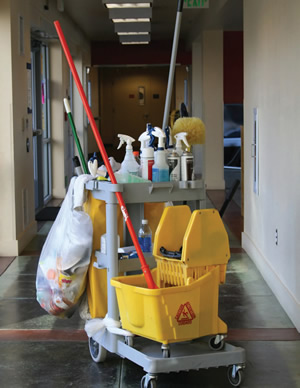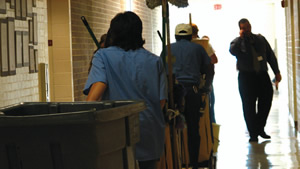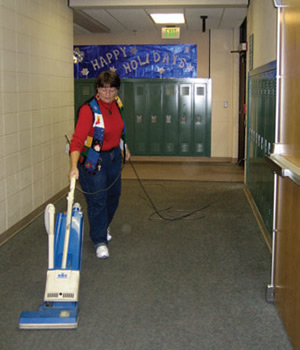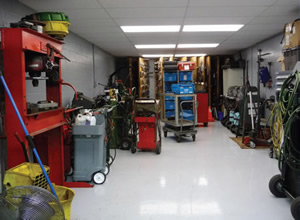Back to the Chalk Board

PHOTO © STEPHEN COBURN
When it comes to facilities management, operating and maintaining even a single school can be daunting. The complexities of running an entire school system are even more so. From the extraordinary demands placed on buildings and systems that accommodate large numbers of active young people for increasingly long hours, to the extraordinarily high expectations with regard to shrinking budget, security, safety, cleanliness and operational efficiency, schools are among the most challenging facilities to operate and maintain.
For administrators and educators, satisfying those high expectations and keeping facilities in good working order means compromise: attempting to strike a balance between the (sometimes competing) priorities of logistics and learning. Where do increasingly scarce financial and personnel resources go? How do you keep schools not just running efficiently, but in a manner that provides students and staff members with a safe, clean and welcoming facility — an environment that is conducive to learning? Some forward-thinking school systems and proactive educational professionals have begun to answer those questions and address those educational infrastructure challenges in a new and compelling manner: adopting a maintenance and service model that relies on a complementary and synergistic management and maintenance strategy: a holistic approach.
This holistic perspective — thinking about building maintenance processes and facilities team members as a cohesive whole, rather than separate pieces — enables administrators and maintenance professionals working in educational facilities to generate and utilize valuable new efficiencies, lower costs and generally do more with less. Adopting a holistic strategy and realizing the full range of potential benefits requires a shift in perspective, however. Holistic maintenance and management strategies demand long-term vision instead of short-term focus, proactive strategies instead of reactive measures, and a newfound appreciation for the value of detail and nuance. In many cases, it means making tough decisions about the people, processes, training and techniques that have been in place for years.

PHOTO © TAYLORTEACHER71
Successful application of holistic maintenance and management principles and strategies, however, has the ability to generate transformative new efficiencies and realize potentially dramatic ROI. At a time when budgetary belt-tightening is part of daily life for so many school systems, resource management can be a source of potentially enormous cost savings. For educators looking for a way to maintain focus on a learning environment instead of devoting inordinate amounts of time and energy worrying about food service, facilities upkeep and maintenance, a holistic approach has the promise to be a true game changer.
A new perspective
The increasing popularity of holistic maintenance and management strategies likely has a lot to do with necessity: the institutions and obligations surrounding educational facilities are changing in some profound and important ways. One important shift is the degree to which public education is becoming an increasingly competitive environment. All public schools are now competing with charter schools, private schools and with each other through schools of choice — both for students and for funding. Parents and communities demand the best in technology and facilities, and, in most cases, that requires a dramatic cultural and professional shift. Doing more with less is no longer a preference so much as it is a necessity. In this competitive atmosphere, schools and school systems need to think hard about how (or even if) they are differentiating themselves, and how to ensure that the largest possible percent of resources go toward education.
To achieve this, district leaders are beginning to understand that they will have to actively change their mindset with regard to how they interact with support services. Many districts have driven themselves into financial problems because they aren’t actively analyzing costs and returns for facilities — both for personnel and physical resources. While the specific facilities issues will vary from one school to the next, and may depend largely on the characteristics of the individual school district, the broader pattern is the same virtually everywhere: expectations are rising and resources are more precious than ever. Administrators need to respond to this new environment and these new demands by making hard and necessary decisions, or parents will make them for you — by moving away or sending their kids (and often the accompanying dollars) away with them.

PHOTO © JLAB140
The Bigger Picture. Individually, many of the strategies behind a holistic maintenance and management approach are simply an extension of logical best practices. In combination, they magnify the benefits and have the potential to leave a profound and lasting positive impact on every part of a school district’s facilities management process.
Process and protocol
Holistic maintenance and management begins with the understanding that everything matters, and that major improvements can be realized from small changes. Whether changing a light bulb or mopping a floor, every task requires a thoughtfully conceived and comprehensive process. That process must be both repeatable and teachable: the result of an exhaustive search for the most efficient, effective and cost-effective approach. As each process is refined and perfected, supervisors need to be diligent about training and educating each team member: translating theory into practice through repetition and education.
At the other end of the scale from those fine details and processes is the big picture: taking a step back and implementing preventative maintenance metrics and procedures for facilities and equipment. School systems can streamline workflow and save time, money and energy with a proactive and predictive repair and replacement policy. Part of it is a mindset, reinforcing the value of efficiency and time-saving strategies for personnel, but it is also about designing an effective top-down process: a year-round, strategic approach that addresses regular seasonal obligations. The goal is to maximize the “tool time” and minimize wasted energy. The result of these strategies can be a staff-, facility- and district-wide approach that elevates the posture of maintenance and management personnel from one of reactive repair and response to one of proactive maintenance and problem prevention.
Training and engagement
Taking newly efficient processes from concept to execution is the first step, but the lasting value comes from making them second-nature. Doing so requires a sustained commitment to employee training. Holistic maintenance and management relies on timely and efficient processes, and on keeping as much work as possible in-house and avoiding the expense and delay of outside contractors. Ensuring that all maintenance and facilities management personnel are trained and up-to-date on the latest equipment and processes is the first step.
When it comes to training and implementing new processes and products, details matter — and oftentimes the best place to get those details is from the horse’s mouth. Ask for feedback from team members who are out there on the front lines. As an organization defines and refines its processes, a holistic approach mandates that maintenance and operations professionals be in on the decision-making process. Coordination across the maintenance and management spectrum is a way to give management a bigger and better perspective on their operations.
One of the challenges that school systems today have to confront is dealing with two different cultures: maintenance and custodial. This dichotomy can be exacerbated by union structures, and can subsequently be difficult to reconcile or resolve. Structural changes are never easy, but bringing separate groups together, as much as possible, improves cohesion and helps emphasize the shared goals and purpose that are critical to making this approach a success.

PHOTO © CADILLACJR2002
Doing More With Less. Forward-thinking school systems and proactive educational professionals are adopting a maintenance and service model that relies on a complementary and synergistic management and maintenance strategy — a holistic approach. This holistic perspective — thinking about building maintenance processes and facilities team members as a cohesive whole, rather than separate pieces — enables administrators and maintenance professionals working in educational facilities to generate and utilize valuable new efficiencies, lower costs and generally do more with less.
The efficiency solution
Proactive maintenance — keeping systems and equipment in good working order and essentially fixing something before it breaks — is a holistic maintenance and management staple. But, another piece of the efficiency pie comes from reducing waste. Reducing or eliminating avoidable waste can save both time and resources, a compelling attraction when
funds are frequently in short supply. The simplest and most significant way to reduce waste is to be smart and coordinated with respect to energy and equipment use. Smart cycling and scheduling for heating and cooling needs during off-peak hours is a must, and encouraging employees to take simple steps such as turning off lights when a room is not in use or shutting blinds before going home for the weekend can make a meaningful difference.
Building use patterns are changing, as well. As the typical day evolves from 7:00 a.m. to 3:00 p.m. toward 5:00 a.m. to 8:00 p.m., accommodating those longer hours without increasing costs means using new tools and solutions to boost efficiency. Technology can help, especially the ability to monitor key equipment from a centralized location. To the extent that it is possible, school systems should ensure that all schools are on the same page from a materials standpoint, as well. Standardizing parts and products across buildings and campuses creates better economies of scale and reduces the inconvenience, delay and expense of having to order new parts every time the need arises.
Thinking holistically
While specific strategies and processes are at the core of any effective and efficient holistic maintenance management program, a school district’s ability to change its mindset is arguably just as important. It is about viewing facilities management through a different lens: focusing less on short-term costs and more on long-term value. It is about being both creative and flexible, training and preparing team members, and, ultimately, minimizing maintenance and repair costs by developing plans and processes that optimize function today and tomorrow.
When educators and administrators approach facilities from a holistic perspective, they make decisions based on what’s best for the whole system over the long-term, which saves money and makes everything run more smoothly. Individually, many of the strategies behind a holistic maintenance and management approach are simply an extension of logical best practices. In combination, however, they magnify the benefits and have the potential to leave a profound and lasting positive impact on every part of a school district’s facilities management process.
This article originally appeared in the issue of .